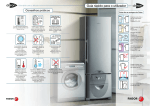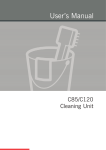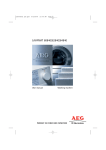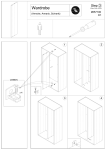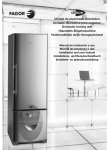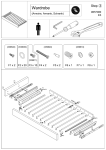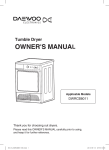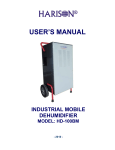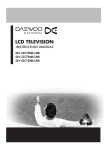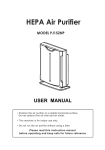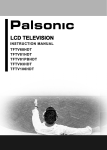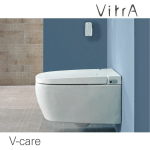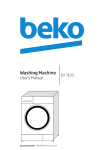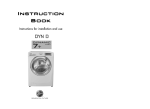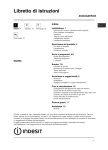Download Unidad de planchado doméstico Unidade doméstica para engomar
Transcript
Unidad de planchado doméstico Unidade doméstica para engomar Domestic ironing unit Huishoudelijke strijk-droogautomaat Haushalts-Bügelmaschine Manual de instalación y uso Manual de instalação e uso Installation and user manual Installatie- en gebruiksaanwijzing Installations- und Benutzerhandbuch English CONTENTS Chapter I - Description of the appliance 56 Chapter II - Installation 1. Unpacking the ironing centre 58 2. Location in the home 59 3. Levelling 59 4. Connection to mains drainage 60 5. Electrical Connection 61 6. Preliminary cleaning 61 Chapter III - Use of the appliance 1. Treatment: types of clothes and fabrics 62 2. Basic features of the Driron 63 3. Accessories for positioning the clothes 64 4. Preparing the clothes 66 5. Placing the clothes in the wardrobe 67 6. Selecting the drying and ironing programme 68 7. Selecting additional programme options 70 8. Selecting the drying level of the clothes 70 9. Turning on the appliance 71 10. Selecting additional functions 71 11. Programme control and progress 72 12. End of programme 74 13. Interruptions to the power supply 74 14. How to collect and store the accessories 74 Chapter IV - Appliance maintenance and cleaning 75 Chapter V - Troubleshooting 1. Table of most common technical problems 76 2. Other technical or practical problems 77 Chapter VI - Practical tips 78 – 55 – Chapter I - DESCRIPTION OF THE APPLIANCE Filter Cabinet Basket Removable top hangers Removable and foldaway bottom hangers Perforated grille Control panel Tank – 56 – ACCESSORIES Hanger 6 units Tenter clip 6 units Sleeve-straighteners 6 units Trouser/skirt clip 6 units Wardrobe door Handle Functional part IMPORTANT If you wish, you can purchase more accessories. There are also small hangers for children’s clothes. Please ask your retailer. – 57 – Chapter II - INSTALLATION 1 UNPACKING THE IRONING CENTRE Remove the protective tapes from the basket and the top and bottom hangers. Remove the accessories that come inside the appliance on a polystyrene tray. The specifications label is located inside the water collection container. This label must never be removed, since it provides information about the exact model of the ironing centre, required power supply, serial number and warranty. 09530100350601002838 ENVIRONMENTAL NOTE This appliance has been designed and manufactured with great care for the environment. Dispose of the packaging in an appropriate way. Select the materials (polystyrene, cardboard, plastic bags, etc.) in accordance with current standards and local regulations governing waste disposal. – 58 – English 2 LOCATION IN THE HOME This appliance does not require special installation but thought should be given to where it is to be located in the home. dimensions width depth height 59.5 cm 67.7 cm 185.8 cm 1. Near the washing machine, to make it easy to move the clothes from one to the other. 2. Make sure that it is well ventilated; in other words, that the air intake and outlet grilles at the rear and on the front (base) of the appliance are not obstructed. 3. If possible, position the Driron in a well-aired, cool place in the home. If the ambient temperature around the Driron is very high, the duration of the programmes could be excessive. If you have installed the Driron outside your home, make sure it is protected from very low temperatures. Otherwise, the water inside the appliance could freeze and burst a pipe or the tank in the interior. 4. Since the air is expelled through the front base of the appliance at a temperature of approximately 40°C, take care when installing it on delicate carpets. 3 LEVELLING For correct operation, it is important for the appliance to be installed perpendicular to the floor; adjust the two front legs and use a spirit level to level the appliance. – 59 – 4 CONNECTION TO MAINS DRAINAGE The Driron has a condensation system that extracts the humidity from the clothes during the drying process. This humidity is turned into water. There are two types of installation: drainage to the mains or collection of the water in the removable container in the appliance. Connection to the drain system: If the appliance is located such that it can be connected to mains drainage, the condensated water will be discharged to mains drainage. Proceed as follows: a At the rear of the appliance, unscrew the pipe bracket. Remove the pipe from the nozzle and leave it hanging where it is. b The drainage pipe is in the top basket inside the appliance. First of all, fit the pipe to the drain and then to the nozzle. Fasten the bracket. c There should be a fixed water outlet drain at a distance of between 25 and 100 cm from the floor. d Make sure that the drainage pipe is not bent or squashed. b a min. 25 cm max. 100 cm c b1 d IMPORTANT Make sure that the bend pipe of the drainage pipe is securely fitted to the outlet so that it does not come away and cause flooding. Collection of the water in the removable container in the appliance: If the appliance is not connected to the home drains, the water will automatically be collected in a removable container in the bottom drawer at the front of the appliance. This container must be emptied after each drying cycle. – 60 – English 5 ELECTRICAL CONNECTION See the specifications label inside the water collection container drawer before connecting the appliance to the mains. Make sure that the mains supply is as shown on the label. 09530100350601002838 specifications voltage 230 V- 50 Hz current 11 A maximum power 2.600 W 6 IMPORTANT Make sure the Driron is connected to an earthed plug socket. The electrical installation, plug, socket, fuses, circuit-breaker and meter must be capable of the maximum power shown on the specifications label. If the power cable is damaged, it must be replaced exclusively by the manufacturer, after-sales service (TS) or authorised personnel. PRELIMINARY CLEANING Once the Driron has been installed and before its first use, the inside of the wardrobe must be cleaned. a Clean it with a damp cloth to remove any dust. a – 61 – Chapter III - USE OF THE APPLIANCE 1 TYPES OF CLOTHES AND FABRICS Types of clothes that can be treated in the Driron. • The Driron does not cause wear to clothes since they do not move throughout the entire process. They do not rub against each other and the warm air flows over them while they are dried and ironed at moderate temperatures. There is no risk of fading, since they are not exposed to the sun. The deterioration of the fabric fibres is reduced as direct contact with the iron is avoided or minimised. The Driron processes do not use chemical products. As a result, there are very few limitations to the Driron. • The Driron can be used for all kinds of everyday clothing, shirts, T-shirts, blouses, trousers, skirts and, in general, for all machinewashable clothes. • It can also be used for household linen, sheets, pillowcases, towels, kitchen cloths, etc. • It also has a basket for drying small clothes (socks, underwear, etc.), which do not normally need to be ironed. • Take particular care with light knitwear, which should never be hung for drying, since it stretches easily. Given that this clothing does not normally crease, it can be placed in the top basket. • Clothes made of leather, suede, plastic, fur and, in general, clothes that may be damaged by damp and heat must not be treated in the Driron. For this type of clothing, use only the airing and deodorisation programmes. Treating the different types of fibres and fabrics • The Driron can treat fabrics made from all kinds of natural fibre, cotton, linen, wool, silk, flannel, viscose, etc. or fabrics made from combinations of these fibres. It can also treat fabrics which contain a certain percentage of synthetic fibres. • It can also treat fabrics made with synthetic fibres only (conventional polyester, polyamide, lycra, elastane or combinations of these fibres). However, given the popularity of synthetic fibres in recent years, we recommend caution and advise you to look at the manufacturer’s recommendations for drying the fabrics. In any case, it is advisable to position them as far away as possible from the hot-air intake grille at the bottom of the wardrobe, making sure they do not slip and fall on it. Place them on the hangers at the top or, if they do not crease, use the top basket. – 62 – English 2 BASIC FEATURES OF THE DRIRON 1. Ironing and drying all kinds of newly washed garments. The Driron removes the creases from clothes, making it unnecessary to iron almost all everyday garments, leaving them dry and ready to wear. Simply take the clothes from the washing machine, place them correctly in the Driron and select the desired programme. The clothes will be ready to wear or put away in the wardrobe in approximately 120 minutes. 2. Ironing dry garments. The Driron has a specific programme for ironing dry garments that do not need washing either because they have been in the wardrobe for a long time or because they have become creased during a journey, etc. 3. Drying damp clothes. Especially designed as a complementary programme to programmes 1 and 2, for garments that are still damp and for damp clothes in general. 4. Airing dry garments. The Driron airs and deodorises garments in approximately 60 minutes, so they are ready to be worn again. 5. An all-round solution for treating clothes at home. Once the programme has finished, you can leave the clothes inside the Driron until you want to take them out, without having to worry about them getting wet, fading or creasing. With the Driron at home, you don’t need a clothes line or a drier and the pile of clothes waiting to be ironed disappears. Next to the washing machine, it provides an all-round process for garments at home. 6. Automatic programme end. Except for programme (or group of programmes) No. 4, (Drying damp clothes programme and Dry garments airing programme), the machine uses an intelligent electronic control to decide when the clothes are ready and, consequently, when the programme should end. This means you do not have to worry about the appliance or the programme. – 63 – 100101100010100 001000101110100 1001010010111010 010100100010111 000110101001010 001000101110100 1001010010111010 010100100010111 000110101001010 3 ACCESSORIES FOR POSITIONING THE CLOTHES For the correct operation of the Driron, the clothes must be positioned correctly in the wardrobe. To help with this, the Driron comes with a set of accessories made from materials that are heatand humidity-resistant. Hanger: the top part swivels to make it easy to hang the garments and place them in the wardrobe. IMPORTANT You must use the hangers that come with the Driron as they are made of heat- and humidity-resistant material. Hanger Tenter clip: This must be placed on the bottom of shirts and T-shirts for better ironing. They do not need to be used with garments made of silk or viscose or for garments with a high content of synthetic fibres, such as polyester, acrylic, etc. The Driron has two types of Tenter clips: a ‘strong’ clip for shirts in general or for more creased garments; and another ‘light’ clip for cotton T-shirts or garments which may stretch or go out of shape with the stronger clip. Reinforced tenter clip How to use the clips Once the shirt or T-shirt has been buttoned up and placed on the hanger, open a clip and insert the bottom of the garment, making sure that the clip is horizontal and in the middle. Release the clip and let it close. The garment should be clipped tight and stretched along the entire width of the clip. When you place the garment in the Driron, make sure that the clip hangs freely in the wardrobe and does not catch on other garments or on the hangers at the bottom. – 64 – Light tenter clip English Sleeve-straighteners: these help to iron shirt sleeves. How to use the sleeve-straighteners Hold the straightener closed in one hand and insert one in each sleeve, making sure that the fabric of the sleeve is stretched along the entire length of the sleeve. Release the straighteners so that they open and the sleeves are stretched. Leave the lower tips of the straightener outside the sleeve so that it does not overstretch the cuff. Sleeve-straighteners CAUTION Do not use these straighteners when the sleeve fabric is prone to overstretching. Take particular care with the narrow sleeves of T-shirts. Trouser/skirt clip: these clips have been specially designed for the easy hanging of these garments inside the wardrobe. How to use the trouser/skirt clip Attach the clip on the wardrobe hanger, inserting it through the top opening. Insert the trouser leg into the clip from bottom to top and release. When you insert the trousers, the top of the clip opens and, when it is released, it closes to trap the trousers. Do the same with the other leg. Leave the trousers to hang, making sure that both legs are parallel and opposite each other so as not to crease the trousers. To remove the garment, open the top of the clip with a finger and the leg falls out. Trouser/skirt clip – 65 – 4 PREPARING THE CLOTHES Shirt/T-shirt: place the garment on the hanger. Button it up. Place the Tenter clip on the bottom and insert the Sleeve-straighteners. To place it in the wardrobe, make sure the sleeves are in front of the shirt. NOTE: To hang the shirt on the hangers and fit the tenter clip, pull the top basket a little bit out and hang the hanger on it. Trousers: We recommend using two hangers, one for each trouser leg, as long as there is sufficient room in the wardrobe. Hang the trousers upside down, making sure that both legs are parallel and opposite each other. Skirt: Fit to clips on the same hanger. Hang the skirt upside down. Smalls: Lay out the clothes on both levels of the removable top basket. Household linen (sheets and towels): Hang the sheets, pillowcases, towels, etc. directly on the top hangers. Hang the sheets correctly folded. We recommend you use at least two hangers for each sheet for correct drying. – 66 – English 5 PLACING THE CLOTHES IN THE WARDROBE Always make sure the central area of the bottom hangers is free so that the warm air can flow from bottom to top (like a chimney) inside the wardrobe. Make sure that the clothes do not come into contact with or obstruct the lower air outlet grille and are at least 3 cm away. Under no circumstances should garments be placed on the grille. Top basket: Remove the basket, which has a stop to prevent it from turning over and make it easy to put in the wardrobe. Lay the garments out evenly on both levels. Spread the clothes out evenly: Position the clothes evenly, covering all the inside of the wardrobe. Do not put one garment on top of another or pile garments up on the hangers. – 67 – 6 SELECTING THE DRYING AND IRONING PROGRAMME When the clothes have been placed inside the wardrobe, turn the appliance on. The controls are located in the bottom part of the Driron. Button: Delay, Drying time and Airing time Drying level pilot lights Display Programme pilot light Start/pause pilot light Start/pause button Removable tank empty pilot light Removable tank full pilot light Interior tank empty pilot light Switch ON/OFF Programme pilot lights Additional Block option pilot light buttons Programme selector To select the desired programme, proceed as follows: a Press the general switch or programme selector. The control comes out and is set to one of the four programmes available. b Turn the control clockwise to select the desired programme. c The selected programme will appear on the display with the letter ‘P’ and the selected programme number. a c – 68 – b English The Driron has various programmes depending on the treatment to be given to the garments and the type of fabric. PROGRAMME DISPLAY TREATING THE GARMENTS TYPE OF CLOTHES AND FABRICS APPROXIMATE DURATION Programme 1 Ironing and • Newly washed clothes. dryingof newly • All kinds of fabrics (**). washed clothes Programme 2 • Newly washed clothes. Ironing and • From 60’ to 90’ (*). dryingof newly • Crease-resistant fabrics washed clothes (polyester, acrylics, etc.). Programme 3 Ironing dry clothes • Dry clothes that are a little • From 45’ to 90’ (**). creased. • All kinds of fabrics. Programme 4 Drying damp clothes • Complementary programme to porgrammes 1 and 2, for those clothes that are not quite dry. • Damp clothes in general. • From 20’ to 120’ (***). The user selects the duration of the cycle depending on how damp the clothes are. Airing dry clothes Deodorisation • All kinds of fabrics. • From 15’ to 60’ (***). The user selects the time depending on the airing requirements. time Programme 4 + button time (*) The duration of programmes 1, 2 and 3 is set automatically by the appliance using the signals transmitted to the Electronic programmer during the process. Consequently, a cycle can last more or less time depending on the number of clothes to be treated and how damp they are. The table shows approximate times for reference purposes. (**) Programme 3: this programme uses steam and the tank in the bottom of the functional part of the appliance must have sufficient water to generate the steam. This tank is filled with the water that condensates during the Drying and ironing programmes (programmes 1 and 2). The tank may be empty when the appliance is new and neither of the two programmes have been used or it may have emptied as a result of several consecutive Ironing programmes with dry garments. In these cases, one or more programmes must be run with damp garments so that the tank fills up with sufficient water. • From 90’ to 120’: clothes (*). • From 120’ to 180’: household linen (sheets, towels, etc.) (*). (***) The duration of programmes 4 is set by the user using the cycle time button (in minutes). Each time the button is pressed, the cycle time is increased by 20 minutes up to a maximum of 2 hours (120 minutes) for the additional drying programme. And 15 minutes for each press of the button up to a maximum of 1 hour (60 minutes) for the Drying damp clothes. The selected time is shown on the display. Once started, the display shows the minutes remaining to the end of the programme. N.B. In the dry clothes airing programme, it is a good idea to open the Driron and remove the clothes once the airing cycle has finished. IMPORTANT The Driron leaves the factory with the water tank empty. When the appliance is turned on for the first time the pilot light comes on because the tank is empty. Consequently, before using Programme 3 (dry clothes ironing) for the first time, run one or more programmes with damp garments (programme 1 or 2) until the pilot light remains off. – 69 – 7 SELECTING ADDITIONAL PROGRAMME OPTIONS Besides their normal versions, Programmes 1, 2 and 3 include two additional options: economy option and delicates option. ECONOMY OPTION DELICATES OPTION This option offers savings on electricity, although programme time is longer. This option is specifically for delicate clothes. It uses temperatures that are slightly lower and increases the programme time. To select the additional option for the drying and Ironing programme, proceed as follows: Press the selected button. a For the economy option, press button. the b For the delicates option, press the button. The corresponding pilot light comes on. To change a selected option, press the same button again. Then press the button for the desired option. 8 a b We do not recommend the delicates option when the ambient temperature around the Driron is very high. The cycle would last too long. SELECTING THE DRYING LEVEL OF THE CLOTHES Once the programme has been selected, Programmes 1, 2 and 3 let you choose the drying level of the clothes. SLIGHTLY DAMP NORMAL IRONED Occasionally for additional ironing WARDROBE EXTRA DRY For hanging or wearing the clothes Not recommended for delicate clothes To select the drying level of the clothes, proceed as follows: a Press the b Each time the button is pressed, the pilot light for the selected drying level option comes on (up to five presses). button. a – 70 – x1 b x3 English 9 TURNING ON THE APPLIANCE Once the programme and the options have been selected, turn on the appliance. a button and the Press the programme begins. b The pilot light comes on to indicate that the appliance is running. 10 a b SELECTING ADDITIONAL FUNCTIONS Programmes 1, 2 and 3 have two additional functions: time delay function and blocking function, which should be used after the options have been programmed and selected. Function: time delay a To delay the start time, press the button. Each time the button is pressed, the start time is delayed by one hour (from the moment the button is pressed). If the button is pressed twice, the start is delayed by two hours and so on up to a maximum of 24 hours. The display shows the selected time delay. a x1 a b button and the time Press the delay begins to count down. The display shows the time first in hours and, when the final hour is reached, in minutes. Function: blocking This blocks the selected programme. It does not allow changes until the programme has finished. This option has been designed specifically to prevent accidental changes made by children. a b To turn on the blocking function, press and hold down the and buttons for three seconds. The appliance comes on automatically without the need for pressing the button. To deselect this option, repeat the operation. a The pilot light comes on to indicate that the blocking function is activated. – 71 – b x24 11 PROGRAMME CONTROL AND PROGRESS The exact duration of Programmes 1, 2 and 3 can not be known beforehand. It depends on the following: • Amount of garments to be dried and ironed. • How damp the clothes are. • The selected options. The Driron itself determines the end of the programme automatically using its electronic sensors. However, the user can see the approximate phase of the programme at any given time: a Throughout the programme, the drying level pilot light remains on to indicate the target. b At the beginning of the programme, the damp option indicator flashes to indicate the initial phase. c Once the first level of dampness has been reached, the pilot light remains on and the next level begins to flash, and so on until the selected option is reached. The flashing pilot light indicates the phase of the programme. d Once the selected option has been reached, all the pilot lights will be on (not flashing): final phase. a b c d Interrupting the programme a Press the general switch or the button. If you wish to interrupt the cycle, to change the option or the programme, first turn off the Driron, select the new option or programme and press the button. If you only want to interrupt the programme for it to continue later, press the button to pause it and then press the same button when you wish to continue the cycle. Obviously, in these cases, you do not need to open the door. AND YOU SHOULD NOT OPEN THE DOOR. – 72 – English b Opening the door Whichever programme is being used, if the wardrobe door is opened (and it can be opened at any time), the programme will be automatically interrupted. And when the door is closed, it will continue at the point where it was interrupted. IMPORTANT However, we recommend you do not open the door when the Driron is running unless strictly necessary. This is because of the following: • If you are working with Programme 1 or 2, when you open the wardrobe door, all the hot air and damp will escape from inside, which could be very unpleasant for the user. When you close the door, the programme will continue from where it was interrupted, but there may have been a significant loss of humidity and temperature required for the ironing process. This will have a negative effect on the results and lead to an unnecessary use of electricity. • If you are working with Programme P3, besides the reasons given for Programmes 1 and 2, opening the door may, in random cases, cause interference to the electronic safety systems on the appliance, blocking the operation of the Driron and causing the display to show a fault message. If this happens, turn off the Driron (by pressing the general switch) and leave it off for between five and 10 minutes. Then restart the programme. When the programme has been interrupted You may still hear a fan noise inside. This is not a reason for concern. It is a safety device on the appliance which comes on in certain cases and stops automatically after approximately 2 minutes. Noise during the heating and cooling phase During the heating phase, at the beginning of the programme, and during the cooling phase, once the programme has finished, some of the materials with which the Driron has been made expand and contract, making noises inside the appliance. IMPORTANT If you hear noises, do not worry. They are not important and occur naturally. They do not affect the operation of the Driron in any way. – 73 – 12 END OF PROGRAMME a With Programmes 1 and 2, during the 10 minutes before the end of the programme, the display shows the minutes that remain. b Once the programme has ended, a continuous buzzer sounds for three seconds. The word ‘End’ is displayed and the ‘Empty removable tank’ pilot light comes on. Empty it. a b IMPORTANT The Driron memorises the programme and the options selected the last time it was used (except the time delay and the blocking option). Consequently, if you wish to repeat the programme, simply select the desired programme and press the button. 13 INTERRUPTIONS TO THE POWER SUPPLY If the power supply is interrupted, the Driron interrupts the programme. If the supply is reconnected in a time equal to or less than 30 minutes, the programme continues from where it was interrupted. If the power cut lasts for more than 30 minutes, the appliance loses the memory and needs to be reprogrammed. 14 HOW TO COLLECT AND STORE THE ACCESSORIES After using the Driron, follow these instructions to store the accessories correctly: a Hanger: place on the top hangers. b Tenter clip: place on the bottom hangers. Open the clip when attaching it to or removing it from the hanger bar. c Sleeve-straightener: placed on the sides of the wardrobe. d a b c d Skirt/trouser clip: placed on the hangers. This way, you will always have the accessories stored away tidily and in correct working order. IMPORTANT If you need more accessories, they can be bought individually; order them from your distributor. – 74 – Chapter IV - APPLIANCE MAINTENANCE AND CLEANING Perform the cleaning operations regularly so that your ironing centre will last longer. Cleaning the exterior and interior To clean the exterior and the control panel, do not use aggressive or abrasive products under any circumstances; simply use a damp cloth and, if necessary, soap. Cleaning the filter The filter is made up of two elements located at the top of the panel at the back of the wardrobe. Although the drying system of this appliance does not scrape against the fabric and, therefore, no fluff is removed from the garments, we recommend that you check the filter for fibres every now and then. If there are any fibres in the filter, clean it with a dry cloth; do not use water under any circumstances. Emptying the condensated water container The condensated water gradually fills the container. We recommend you empty the container after each programme. This water is not drinkable, but it can be used for domestic purposes (e.g. for steam ironing or in the air humidifier). we recommend you leave the appliance open so that the air can circulate freely around the interior if you are planning to be away for a long period. IMPORTANT Before any cleaning or maintenance operations, unplug the appliance from the mains. – 75 – Chapter V - TROUBLESHOOTING If you discover a problem when using the Driron, you will probably be able to solve it after checking the following table of the most common technical problems. 1 TABLE OF MOST COMMON TECHNICAL PROBLEMS PROBLEM The appliance does not come on. The duration of the programme is too long. POSSIBLE CAUSE SOLUTION • There is no power in the mains or the appliance is not plugged in. • Check that there is power in the mains and that the appliance is plugged in. • After selecting the programme, you have not pressed the start button . • Press the start button • The door is not closed correctly. • Close the door correctly. • The removable water collection tank is not in position. • Put the tank in position. • The removable tank is too full. • Empty the tank. • The clothes have been placed in the appliance when they were too damp. Perhaps they were not spun dry. • Do not put clothes inside the wardrobe if they are too damp. We recommend you spin the clothes in the washing machine at a minimum of 700 rpm. • The air intake (protected with the grille) on the rear of the appliance is obstructed. • Clear the air intake area. Remove obstacles from the air intake. • The filters inside the wardrobe are obstructed. • Clean with a dry cloth. • The ambient temperature of the room where the appliance is located is very high. The high temperatures in the area where the appliance is located hinder the drying process and make it last too long. • Ventilate the room. Open the window or door. Lower the ambient temperature. – 76 – . English PROBLEM In general, the garments, or some of them, do not dry correctly. 2 POSSIBLE CAUSE SOLUTION • The wardrobe is overloaded with clothes. • Do not pile clothes inside the wardrobe. Do not put too many clothes inside the wardrobe. See Placing the clothes in the wardrobe (page 67). • The clothes have not been positioned correctly inside the wardrobe. • See Placing the clothes in the wardrobe (page 67). • Some of the clothes have been placed in the wardrobe when they were too damp. • Do not put clothes inside the wardrobe if they are too damp. • Remove the clothes that have been dried and leave only those that were not dried correctly. Run Programme 4 (Drying damp clothes). OTHER TECHNICAL OR PRACTICAL PROBLEMS When the Driron detects an internal problem, it interrupts the programme and informs you with buzzers and displays. a A buzzer sounds for two seconds. b The display identifies the problem using the letter F (fault) followed by a number (from 1 to 14): • If F1 is displayed, the fault refers to the fact that the door is open or not closed correctly. Close it correctly and the Driron will continue the programme. a • If any other fault (F2 to F14) is displayed, contact the service and maintenance company. – 77 – b Chapter VI - PRACTICAL TIPS 1. About the type of clothes to be treated The Driron can be used for all kinds of everyday clothes, household linen (sheets, towels, kitchen cloths, etc.) and Smalls (socks, underwear, etc.). The Driron can treat fabrics made of all kinds of fibres, but when the fibres are 100% synthetic, we recommend you follow the manufacturer’s recommendations for drying. In any case, position them as far away as possible from the air outlet grille at the bottom. Given that this type of synthetic fabric does not crease, the best place for drying them is inside the top basket. Clothes made of leather, suede, plastic, fur and, in general, clothes that may be damaged by damp and heat must not be treated in the Driron. For this type of garment, use only the airing and deodorisation programmes. Take particular care with light knitwear, which should never be hung for drying, as it stretches easily. Given that these clothes do not normally crease, they can be placed in the top basket. When the Tenter clip is placed on shirts made of corduroy or velvet, we recommend you hang the garments inside out to prevent the clip from marking the shirt. The same applies when hanging up corduroy or velvet trousers. 2. To make it easier to iron garments The best way of ironing the garments is not to crease them too much during the washing-spinning cycle. We recommend the following: • Do not fill the washing machine to excess. • Do not spin clothes at more than 900 rpm. • Hang the garments in the Driron as soon as possible after they have been washed. With the Ironing and drying programmes (programmes 1 and 2), clothes need to be sufficiently damp at the beginning of the cycle. The Driron uses the damp of the garments for the ironing process. This is another reason for not spinning clothes at more than 900 rpm. They would not be sufficiently damp. Make sure the clothes are not pressed against each other (wardrobe too full) as this may hinder the ironing process. The more laid out and flat the clothes are in the wardrobe, the better the result. – 78 – 2. To make it easier to iron garments (continued) 3. To make it easier to dry garments It is important to use the tenter clips and sleeve-straighteners in their correct position to obtain a better finish for shirts, blouses and T-shirts. To do this: • When attaching the Tenter clip, make sure it is not twisted and that the clothes are correctly caught and stretched along the entire width of the clip. • When inserting the clothes, make sure the Tenter clip hangs freely in the wardrobe and does not catch on other clothes or on the bottom hangers. • The use of the Tenter clip with shirts and T-shirts with a high content of synthetic fibre (polyester, polyamide, Lycra, etc.) is not necessary. The use of Sleeve-straighteners is not appropriate when the fabric is prone to being stretched out of shape. The clothes must be spread out evenly around all the areas of the wardrobe. Do not put one garment on top of another or pile garments up on the hangers in the Driron. The clothes must be hung as separately as possible from each other. If two garments are close together, the air cannot flow between them and the surfaces may not dry completely. Consequently, do not overfill the wardrobe. The greater the amount of clothes to be treated and the damper the clothes are, the longer the cycle will be and the more possibility there will be of a garment not being dried sufficiently. For even drying, energy-saving and the correct programme duration, do not mix clothes that absorb a great deal of humidity (towels, thick cotton sheets, etc.) with light clothes of fine fabrics that absorb little humidity in the same cycle in the Driron. The clothes may not dry evenly; some may come out too damp and others too dry. For correct drying-ironing, do not spin the clothes in the washing machine at less than 700 rpm. They would have too much water for the Driron. If there is sufficient room, try to leave a separation between trouser legs, using adjacent hangers. Drying will be better. – 79 – 3. To make it easier to dry garments (continued) 4. Use and location of the appliance Do not pile too many clothes on top of each other in the top basket. Use the intermediate tray of the basket. Do not cover the central area of the basket. When the programme has finished, if any of the clothes are not sufficiently dry, remove the rest and leave the damp clothes inside. Run Programme 4 (Drying damp clothes), which has been designed to solve this problem. Ensure that the Driron is not located in an area with very high temperatures. This will increase the duration of the programmes. We do not recommend using the delicate option when the ambient temperature in the area in which the Driron is located is very high. The cycle would be too long. If you have installed the Driron outside your home, make sure it is protected from very low temperatures. Otherwise, the water inside the appliance could freeze and burst a pipe in the tank. Do not open the door when the Driron is running unless absolutely necessary. ENVIRONMENTAL NOTE INFORMATION FOR THE CORRECT HANDLING OF WASTE FROM ELECTRICAL AND ELECTRONIC APPLIANCES At the end of the service life of the appliance, do not dispose of it together with general domestic waste. It can be taken, free of charge, by specific waste collection centres approved by the local authorities or removed by distributors that provide this service. To emphasise the obligation to collaborate with selective waste disposal, the product bears the mark which warns of the non-use of traditional containers for its disposal. For further information, please contact your local authority or the shop where you bought the product. Disposing of domestic appliances separately avoids possible negative consequences for the environment and for health resulting from inappropriate disposal and also makes it possible to treat and recycle materials to obtain significant savings in energy and resources. – 80 – Fagor Electrodomésticos, S. Coop. Apartado 49 Tel. 943 719 100 / 01 Fax 943 796 881 B° San Andrés, 18 20500 MONDRAGÓN (Gipuzkoa) Internet: http://www.fagor.com e-mail: [email protected]




























